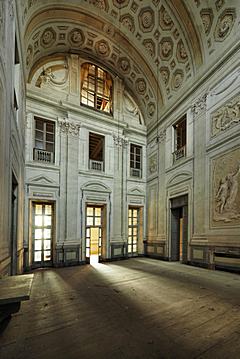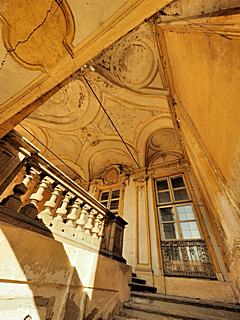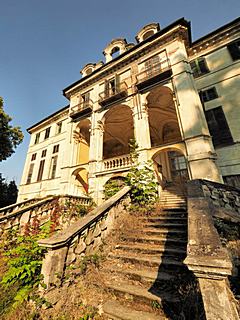
- Home
- Lost Places
- Ressourcen
- Mittelalterliches
- Lokalgeschichte
- Portfolio
- Über ...
- Feedback
- Impressum
- Sitemap
- VIP
- Home
- Lost Places
- Mittelalterliches
- Lokalgeschichte
- Portfolio
- Über ...
- Feedback
- Impressum
- Sitemap
- VIP

Villa C
(Oktober 2016)Die 600 Meter lange Pappel-Allee deutet es schon an - dies ist kein Haus für Normalbürger. Alles ist auf Repräsentanz ausgerichtet, es fehlen eigentlich nur noch Skulpturen in Garten und Vorfahrt. Aber wer weiß ... im Inneren quoll die Villa einst über vor Kunstschätzen, welche die hier wohnende Familie sammelte. Übrig geblieben sind davon zahlreiche Nischen und Stuckrahmen für die Kunstwerke - und die all gegenwärtigen Bewegungsmelder. Nur der Hausmeister durfte damals die Villa betreten, niemand sonst im Ort hatte Zutritt zu diesem Teil des Palastes.
Einer der letzten Bewohner war der adelige Spross einer Familie, die einem weltbekannten Wermut ihren Namen lieh. Sein Leben war das eines typischen Jetsetters, er vertrieb sich die Zeit mit Bobfahren und Powerboat-Rennen. Angeblich gehört die Villa schon seit Jahrzehnten Eigentümern aus der Schweiz, steht aber auch schon ebenso lange leer. Sie wird inzwischen zum Verkauf angeboten, näher rückende Reihenhaussiedlungen und ein nahes Gewerbe- und Industriegebiet mit endlosem LKW-Verkehr dürften geneigte Kaufinteressenten aber eher abschrecken. Wer solch ein Gebäude sucht, wird ein anderes Ambiente wählen. Da die Villa außerdem den Status eines Nationaldenkmals hat, gibt es mit Sicherheit entsprechend enge Auflagen hinsichtlich der Sanierung.
Im Kern basiert die heutige Villa auf einem feudalem Schloss aus dem 17. Jahrhundert, das aber in der zweiten Hälfte des 19.Jahrhunderts zu seiner heutigen Form umgebaut wurde. Zu ihm gehört auch die angegliederte Kirche und ein Garagentrakt. Der etwa 150.000 qm große Park nebst rundem Teich ist inzwischen stark verwildert. Ungewöhnlich empfand ich den repräsentativen Eingang auf der Gartenseite - offenbar konnte man das Gebäude durch einen Durchgang im Erdgeschoss passieren und dann diskret von der Rückseite betreten.

Villa C
(October 2016)THIS IS A GOOGLE TRANSLATION, WILL BE CHANGED SOON: The 600-meter-long poplar alley already indicates it - this is not a house for ordinary citizens. Everything is centered on representation, only sculptures are missing in the garden and right of way. But who knows ... in the interior, the villa once overflowed with art treasures, which the family living here collected. Numerous niches and stucco frames for the works of art, as well as the all-present motion detectors, remain. Only the caretaker was allowed to enter the villa at that time; no one else in the place had access to this part of the palace.
One of the last inhabitants was the aristocratic sprout of a family who lent its name to a world-famous wormwood. His life was that of a typical jet setter, he drove the time with bobsleighing and powerboat races. It is said that the villa has been owned by Swiss owners for decades, but has also been empty for quite a while. It is now offered for sale, closer-reaching row house settlements and a close commercial and industrial area with endless truck traffic should rather deter inclined buyers. Anyone looking for such a building will choose a different ambiance. Since the villa also has the status of a national monument, there are certainly correspondingly limited conditions with regard to the rehabilitation.
In essence, today's villa is based on a feudal castle from the 17th century, but it was rebuilt into its present form in the second half of the 19th century. To him belongs also the attached church and a garage contract. The approximately 150,000 square meter park with a round pond has now become very bad. Unusually I felt the representative entrance on the garden side - obviously you could pass the building through a passage on the ground floor and then enter discreetly from the back.
Recent state: slow decay
Abgerufen: 22.10.2024 - 21:13 Uhr
Autor: Klaus Lipinski, Düsseldorf
Email: info(at)lipinski.de
Texte und Fotos unterliegen den auf der Website definierten Urheberrechten.























